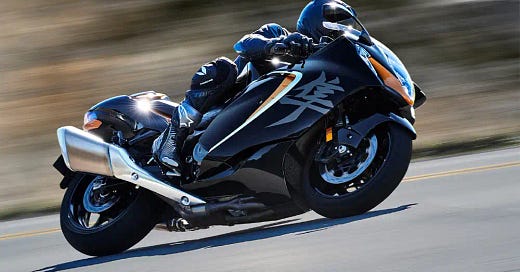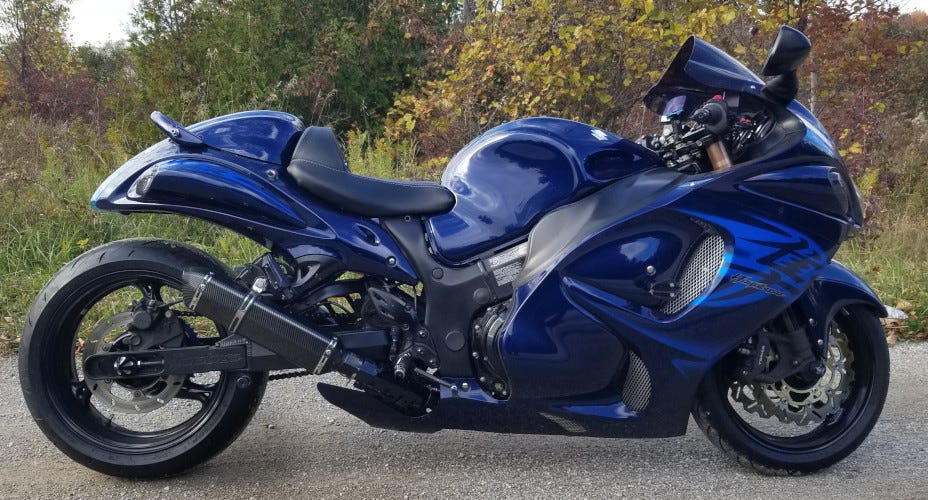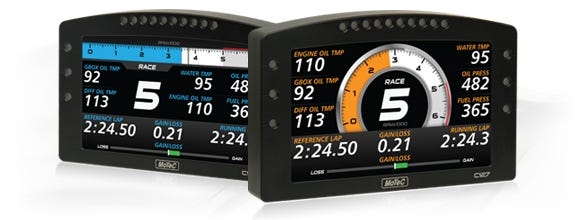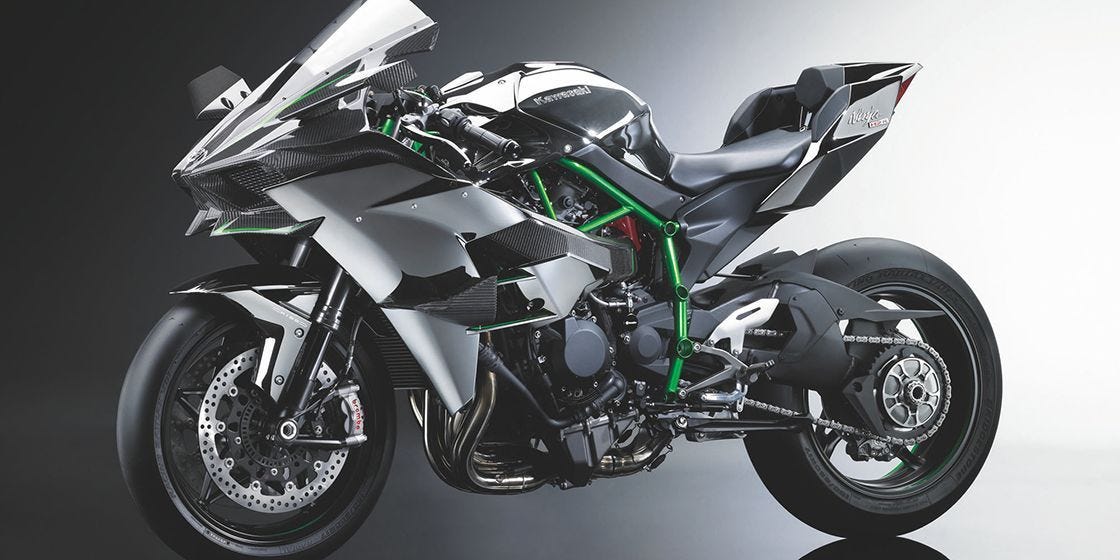Lowest Priced Turbo Bike
Our ultimate turbo streetfighter pick, based on power, affordability, easy install and reliability. Big story, lots of information…
Build Your Own Naked Streetfighter
The Suzuki Hayabusa has always been the motorcycle of choice for big power. The reason for this began in 1999, when the Hayabusa was introduced and overtook the previous fastest motorcycle, the Honda Blackbird. So the Legend began for the Hayabusa as did the proliferation of a multitude of performance parts, turbos, superchargers, swingarms, tuning components etc. Everyone jumped on this new leader in motorcycle performance.
That is until the Kawasaki H2R came along. Heralded as the fastest motorcycle ever made, the H2R made quite a stir. Its builtin supercharger performed well. So here it was, a brand new Kawasaki motorcycle with a supercharger that became the new king of the stockers.
The only problem was that the price tag was out of reach for most riders and also it was what it was… a stock supercharged motorcycle!
Unlike the Hayabusa, with tons of options both cosmetic and power, did the H2R really unseat the Legendary Hayabusa? Also, lets not get confused with other H2 models that barely put out what other sport bikes do in raw stock power.
When Suzuki released their newest Gen3 model, followers were vastly disappointed. The Gen3 did not have a supercharger or a turbo and did not measure up to the new Kawy H2R at all, or come even close. Disappointment from around the world. What the hell happened with Suzuki? Well, they obviously felt their Gen3 was still a leader, but they were not going to bring out a bike that was out of most riders price range. And to this point, Suzuki has always been a leader in competitive pricing. Nor were they going to gamble on a very, very narrow market, just to claim leader of the pack status in stock motorcycles. They knew that Kawasaki spent a fortune on the H2R that in no way was going to pay off.
The problem for the H2R, was that it was a defined very expensive stock superbike with no options. No way to modify the tightly put together supercharged bike. No mod kits, no adjustments… everyone gets the same stock bike.
So did the Hayabusa Legend really die? Maybe not. Put a turbo or supercharger on the Hayabusa, guess what, it’s faster! Hayabusa turbo bikes have been pulling quarter mile times in the 5.xx second area, sorry but not going to happen on an H2R. Google H2R times, best at high 8’s.
In the Hayabusa realm, it’s the Gen2 that is the go to model for performance. The Gen3 is newer (with slightly lower hp) and custom products have not caught up to it yet, plus it is burdened with what many say are just too dam many electronics (designed to pass all the ever increasing emissions requirements by a number of countries). While some developers are finding ways past all of this, it’s a long drawn out debacle compared to the overly simplified, old school Gen2.
Lastly, the other reason the Gen2 is the motorcycle of choice over the Gen3 is cost. The Gen3 is a lot more expensive to turbocharge due to the additional electronics that are required. For example, currently to get the tune for a performance Gen3, a MaxxECU is required at approximately $3k or similar Motec similar price range.
Regardless, the Hayabusa Gen1 and Gen2 are definitely still the fastest at the drag strip. But what about the Street? Yes, the Hayabusa continues to be a street contender, but lets face it, street racing is a tricky thing to judge. You have to be picky where you can ride and use all that power. High horsepower bikes tend to spin a lot on paved roads. Drag racing tracks are different, they are tarred and not slippery.
New vs Built Streetfighter
The out of the box Streefighter King would most definitely be the H2R. Right?
But we know that the H2R is stuck at its power range of 300 hp and costs $58,000, not what your average biker is going to pay. The H2 SE SX puts out 200hp and costs $33,000. Other sport bikes in the 200 hp are around $18-28,000 and most manufacturers have them. Yet, why Suzuki still tends to be the go to performance bike… is the wide range of options in available performance products, results at the track and usually the lowest prices in stock power bikes.
We have found that there are many, many riders that want power, but just do not want to pay this kind of money for a fast motorcycle. Some will buy parts and assemble their own turbo installations and while this is possible, it’s a ton of work, finding the turbo, the manifold, the plenum air box and getting it all to work… it’s a long haul to get there and quite frankly some never do. Far better to get a proven, complete established bolt on kit.
Enter the Bandit
The Lowest Cost 1200 Used Candidate as Well as the Easiest Installation of Any Bike.
Our initial goal was to build a fast bike cheap and we achieved that after a lot research with a 2000 GSF1200 Bandit. There are a ton of Bandits available out there that are very affordable. The all inclusive turbo kit from Proboost is also very affordable and one of the oldest, most established and proven kits in the world.
How affordable you say. Well in our experience, the next contender, a good used Gen2 Busa we found ranged from $7-$10k, whereas a good used Bandit was half the price at $3-$6k. A substantial difference. Besides being easily able to find a good affordable Bandit and a turbo kit that had everything needed for the install, the best news was just how dam easy the installation was.
No fairings to pull off, radiators and most importantly, not having to pull the engine out to put in a spacer to lower compression. Nope none of that with the Bandit. It literally just bolts right on and with the Proboost turbo kit, it comes pretuned. Easy install and ride.
That’s it right? Well almost. Our goal was to build a streetfighter naked bike. We didn’t want a stocker turbo Bandit, we wanted a great looking turbo streetfighter.
Why Buy a Bandit if You Have a Fast Bike
Some riders want to turbo their new bike, but are apprehensive about having to take the engine apart to put a spacer in, to lower compression. By the way, this is absolutely needed for the turbo if the bike has a high compression engine. Riders may also be concerned about damaging their new bike they just paid a lot of money for.
Well our answer to this is, buy a Bandit for $3k, put a turbo on for $3k and its cheaper than putting a turbo on your sport bike or Hayabusa and you can beat the shit out of the Bandit all day long and have your sport bike for bigger rides and not worry about damaging it. Also, it is no easy task to take the engine out to put in the spacer. Even if you are doing it yourself it takes time. And the big attraction of the Bandit is, this huge step is not necessary with the Bandit.
Installation Details
Details on Chopping the Bike, Fitting an Exhaust and Controlling the Turbo/Ride.
Step 1 - Stripping Down the Bandit:
A Bandit was purchased and the only thing we did before handing the money over was a compression test. The results were acceptable for a 24 year old motorcycle with 34k on the odometer and based on experience, we felt the general condition was good to go.
We knew what we wanted right from the start, so with the bike on the table we started stripping and we went right to it, got rid of fairing, front end lights, pulled the tank, exhaust, manifold, carbs, airbox, seat, wheels, tank, lighting, handlebar, levers, grips and pretty much everything that we could wrench.
The next thing was to thoroughly clean the tank and the carbs and here we took our time to get this right, no shortcuts. We made sure both were spotless. After all, with it all apart and putting a turbo on, clean gas and fuel had to be right. We were surprised at just how much gunk was in both, but then, the bike was 24 years old, so not really a surprise
Step 2 - Cleaning, frame cutting, carb mods and turbo installation:










